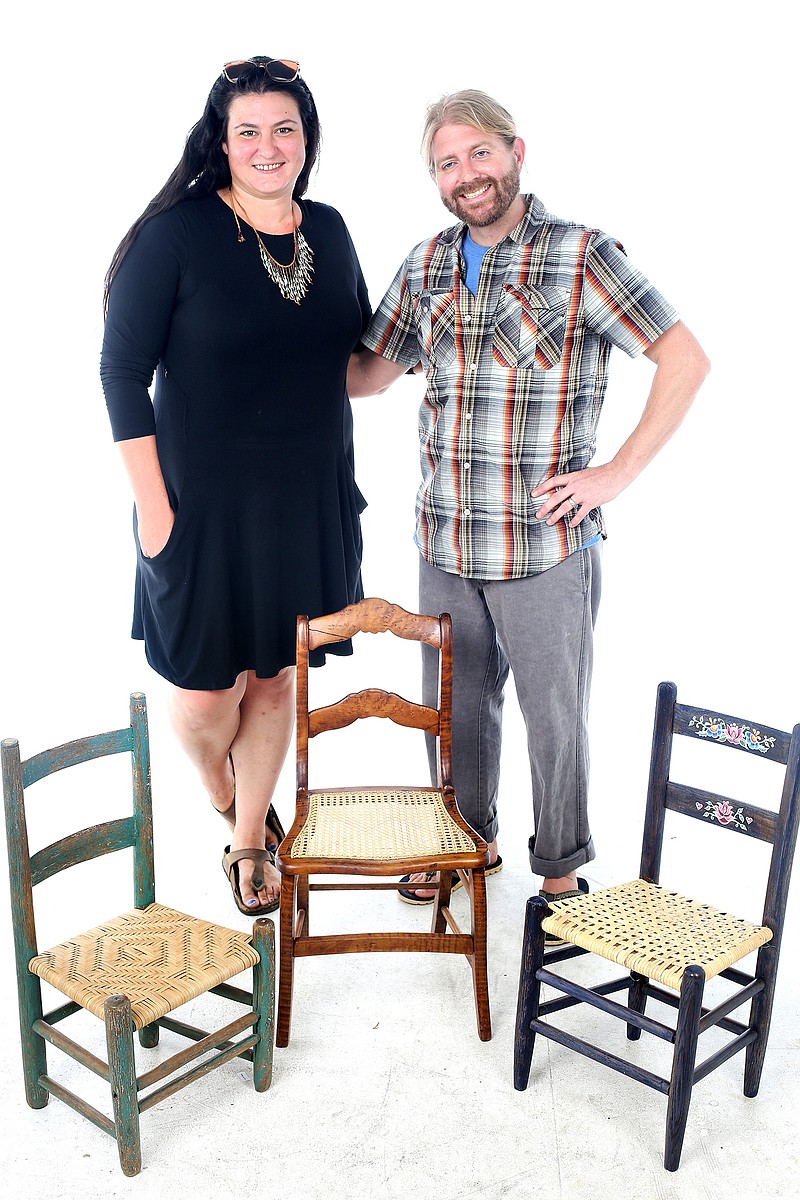Name: Taft Cardwell
Age: 36
Hometown: Nashville
Name: Jill Cardwell
Age: 35
Hometown: Chicago
Occupation: Owners of Cardwell Caning
Upon entering Jill and Taft Cardwell's home, books coordinated by hue catch your eye in the living room. In the kitchen, it's bowls stacked in primary colors. And then there are the chairs. Three stacked in the corner of the living room, eight miniature ones by the mantel, four more on top of the piano, two on top of a table. And that's not counting all the chairs in the shed.
The Cardwells operate Cardwell Caning, restoring the woven rattan cane commonly found in antique furniture or rocking chairs. Taft's parents, who are both school teachers, used to weave and restore rattan chairs as a side hustle, and about three years ago, while working refilling vending machines at truck stops, he decided to pursue the same. "I felt like I had a higher purpose," Taft says. Jill, who worked in restaurants at the time, joined him.
Caning can be traced back across ancient China and Egypt, but hit peak popularity in the 17th and 18th centuries in Europe. Before the Industrial Revolution, weavers would spend hours crafting designs, threading a long piece of rattan palm over and under to perfect the seat. Once machines were able to produce the intricate designs that could take the human hand weeks to complete, the hobby lost popularity.
But the chairs still hold a special place for many people. The busiest time of year for the Cardwells is right before Thanksgiving when people realize they're having guests over and need to fix that broken chair that's seen decades of celebrations. Or right after spring-cleaning fever strikes and an old rocking chair is found in a forgotten corner.
Using pliers, tweezers and golf tees as pegs to hold the cane - which could be anywhere between 10-12 feet long - in place, the Cardwells form a two-man assembly line to restore these family treasures, going back and forth until their bodies tell them to stop.
Taft: It's hard work, but it's rewarding. Some chairs will take, no exaggeration, 20 hours to do. I'll cane until my eyes cross.
Jill: You're standing or crouching and it's about how much your body can take.
Taft: As a child, I can remember rolling over in bed, the view straight to our kitchen, and my parents would be up at midnight with chairs on the table just weaving away to make extra money.
Taft: My dad taught at the Tennessee School for the Blind and there was a workshop class that, believe it or not, taught caning. He learned by grabbing a chair, bringing it home and then started figuring out where each piece went, which order to do all this.
Taft: It just looks like a plate of spaghetti ... and you have to slowly put this thing in order. And after each step, you have to stop and you have to straighten it, because it won't straighten itself, which is something I've learned.
Taft: People think that this type of chair can only be done in one or two ways. No, we can twist up old Kroger or Walmart bags and we can make something totally new that no one has ever seen before. We could weave wire, belts, ties.
Jill: People will come up to us at the [Chattanooga Market] and go, "Don't we have great-aunt-so-and-so's rocking chair in the attic?" People bring us all kinds of things from the attic, and we get to breathe new life into it.
Taft: When someone calls and says, "Hey, I need your services," we really initially don't know what that means, which kind [of weave] we're going to be working with. And we have to be ready no matter what it is, even if it's something we've never seen before.
Jill: How soon do we have to have it done? Three days? We'll have it done.
Taft: Caning is really hard to talk about because there's so much interchangeable lingo. A customer will call up and say, "It has some vertical and some horizontal," but that could be anything. There's a couple of different fundamental types of caning. So we got miniature versions. These are our examples so people can come up and say, "I have a chair like that."
Jill: A man came up to us and said he rocked all his kids in this chair and now he has a grandson and all he wants to do is rock again.
Taft: Some customers brought in these chairs that have been around for 200 years in their family. They had them for 20 years, and one thing that I kept thinking about is where were these chairs for the other 180 years? Were they in Tennessee or even in the South? Where have they been? How many children have been read books on these? How many meals have been shared? Thanksgiving dinners? Christmases?
Taft: We're in the business of creating heirlooms and preserving the history of woven furniture. It's very unique and sturdy.
